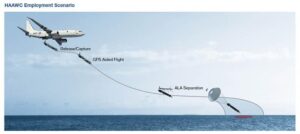The Navy on Aug. 19 awarded Boeing [BA] a full-rate production contract for the High-Altitude Anti-Submarine Warfare Weapon Capability (HAAWC), which allows P-8As to launch torpedoes from high altitudes.
The contract is a $26 million firm-fixed-price full rate production contract to produce the HAAWC Air Launch Accessory (ALA) equipment, related engineering and hardware repair services and other direct cost support. It includes options that, if exercised, would raise the total value to $121 million.
The HAAWC is carried by a Boeing P-8A Poseidon maritime patrol and reconnaissance aircraft, to aid anti-submarine and anti-surface warfare by launching a torpedo from higher altitudes and longer distances.

The HAAWC includes a modular ALA kit attached to a Mark 54 torpedo that turns it into a precision-guided glide weapon launched near or below the cruising altitude of a P-8A.
The company noted that following GPS-aided flight to the water surface, the HAAWC reaches the ALA separation point when it then deploys a stabilizer to let the torpedo enter the water as intended.
“This is an important milestone because it brings HAAWC one step closer to becoming fully operational and deployed by the Navy,” Dewayne Donley, Boeing’s HAAWC program manager, said in a statement.
“Our solution transforms the MK 54 into a precision glide weapon in GPS-aided and GPS-denied environments. The HAAWC system provides flexibility by allowing the Navy to carry out anti-submarine operations throughout the full flight envelope of the P-8A,” Donley added.
Boeing said this contract covers production of HAAWC ALA kits and containers for U.S. and international customers and also includes provisions for item order option allowing the Navy to procure spare hardware support, design studies, repair services, testing prototyping and/or analyses of production-related issues.
Work will largely be split among St. Charles, Mo. (44 percent); St. Louis, Mo, (26 percent) and Salt Lake City, Utah (12 percent) and is expected to be finished by September 2024. However, if all options are exercised, work will extend through September 2030.
The contract announcement noted this was not competitively procured in accordance with regulations with only one responsible source.
The Navy has been developing this capability for over 13 years. Previously, Raytheon Technologies [RTX] and Lockheed Martin [LMT] also worked on this kind of capability (Defense Daily, Sept. 24, 2009).